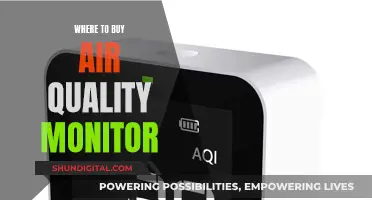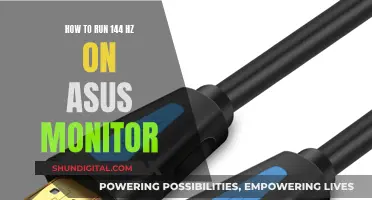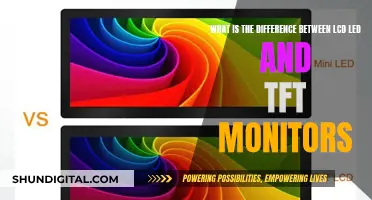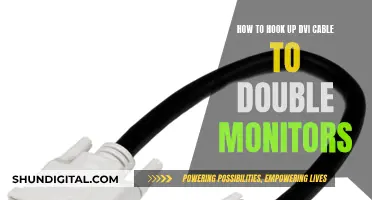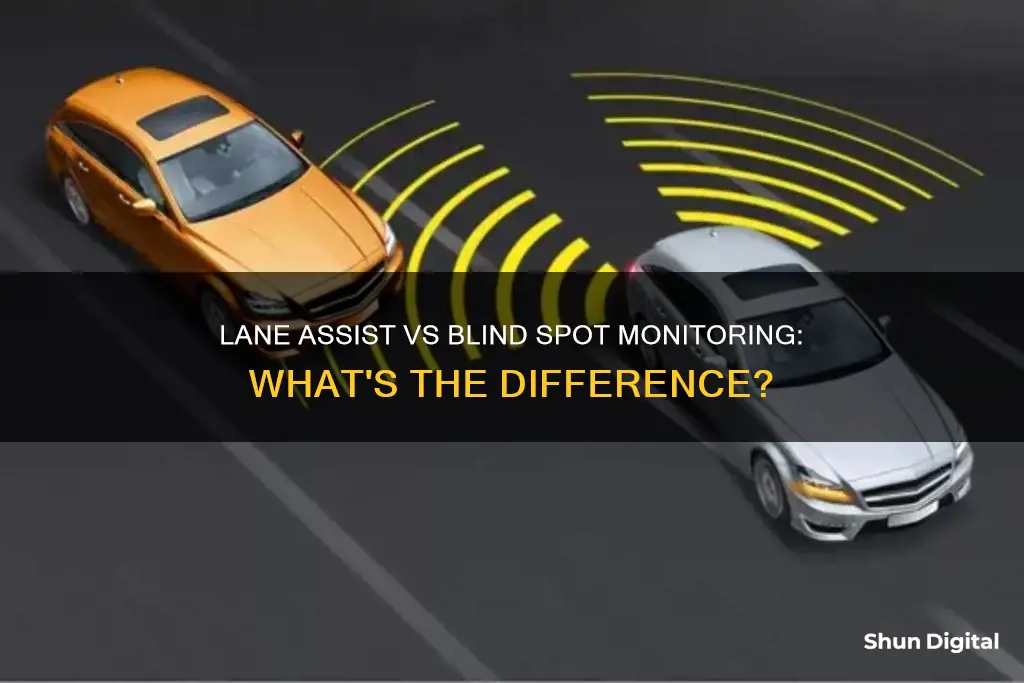
Lane assist and blind spot monitoring are two different systems that promote driver safety. Lane change assist uses sensors or cameras to scan the road and detect lane lines to help the driver switch lanes safely. It also uses sensors to detect the speed and position of surrounding cars and determine whether there is a collision hazard. On the other hand, blind spot monitoring uses sensors on the back and sides of the vehicle to alert the driver of cars that are quickly approaching in the vehicle's blind spot. While these two systems are bundled together in many vehicles, they are not the same and serve different purposes.
| Characteristics | Values |
|---|---|
| Purpose | Lane assist: Helps drivers switch lanes safely. |
| Blind spot monitoring: Alerts drivers to vehicles in their blind spot. | |
| Function | Lane assist: Detects lane lines and helps drivers switch lanes. |
| Blind spot monitoring: Uses sensors to detect vehicles in the vehicle's blind spot. | |
| System | Lane assist: Uses cameras and line tracking technology. |
| Blind spot monitoring: Uses sensors and, in some cases, cameras. | |
| Alerts | Lane assist: Visual, audible, and vibration alerts. |
| Blind spot monitoring: Visual, audible, and vibration alerts. | |
| Activation | Lane assist: Activated by the driver or when the vehicle deviates from its lane. |
| Blind spot monitoring: Activated when a vehicle enters the driver's blind spot. | |
| Limitations | Lane assist: May have difficulty detecting lane markings in poor visibility or inclement weather. |
| Blind spot monitoring: May have difficulty detecting fast-moving or smaller vehicles. |
What You'll Learn
- Lane change assist uses sensors or cameras to scan the road and detect lane lines to help the driver switch lanes safely
- Blind spot detection uses sensors on the vehicle's exterior to alert the driver of cars in their blind spot
- Lane departure warning systems notify the driver when their vehicle leaves its lane but do not actively intervene
- Lane-keeping assist attempts to guide a drifting vehicle back into its lane without driver assistance
- Advanced driver assistance systems (ADAS) are designed to make driving more convenient, but they do not replace the need for a skilled human driver

Lane change assist uses sensors or cameras to scan the road and detect lane lines to help the driver switch lanes safely
Lane change assist and blind spot monitoring are two different systems, but they both aim to improve driver safety. Lane change assist uses sensors or cameras to scan the road and detect lane lines to help the driver switch lanes safely. This system is designed to make lane changes safer and prevent collisions with other vehicles.
Lane change assist systems use sensors or cameras to scan the surroundings of the road. They detect the speed and position of surrounding cars and determine if there is a risk of collision when changing lanes. If a risk is detected, the driver will be alerted to take evasive action. These alerts can come in the form of sounds, lights, or symbols on the dashboard or steering wheel. Lane change assist can also be bundled with blind spot detection, which uses sensors on the back and sides of the vehicle to warn the driver of any vehicles in their blind spot.
The Porsche Lane Change Assist (LCA) uses radar sensors to monitor the areas to the rear of the vehicle and the blind spots on either side. It provides a visual warning signal in the exterior mirrors if another vehicle is approaching from behind or is in the driver's blind spot. This system also includes a Turn Assist feature, which improves safety during low-speed turns by warning the driver of objects in the blind spots when approaching an intersection.
Lane change assist is an important feature for improving road safety, especially on highways and in urban areas. It helps reduce the risk of accidents caused by lane changes, which can be dangerous, especially on high-speed roads. However, it is important to note that lane change assist systems may have limitations, such as difficulty detecting fast-moving vehicles or motorcycles, and they should not be solely relied upon. Drivers should remain attentive and use turn signals before changing lanes.
Best Monitor Options After the ASUS TUF VG24VQ
You may want to see also

Blind spot detection uses sensors on the vehicle's exterior to alert the driver of cars in their blind spot
Blind spot detection and lane assist are two different systems, but they are both important safety features in modern vehicles.
Lane assist, also known as lane departure warning or lane-keeping assist, uses cameras or sensors to detect lane markings and help the driver stay in their lane. If the vehicle starts to drift out of its lane, the system will alert the driver through visual, audible, or haptic feedback, such as a warning light, a buzz, or a vibration in the steering wheel or seat. In some cases, lane assist systems can also actively intervene to steer the vehicle back into the correct lane or apply the brakes to prevent lane departure. Lane assist is particularly useful for long highway drives, driving at night, or when the driver is feeling drowsy.
While both systems are designed to improve safety and reduce accidents, they have distinct functions and features. Blind spot detection focuses on alerting the driver to vehicles in their blind spot, while lane assist helps the driver stay within their lane and avoid unintentional lane changes.
VA Monitors: LCD Revolution for Your Setup
You may want to see also

Lane departure warning systems notify the driver when their vehicle leaves its lane but do not actively intervene
Lane departure warning systems and blind spot monitoring systems are two of the most common and useful systems available in modern vehicles. While both are designed to improve driver safety, they are not the same. Lane departure warning systems use a camera to monitor the vehicle's position in its lane and notify the driver when the vehicle leaves its lane. This is a passive system, meaning it does not actively intervene to prevent lane departure. Instead, it relies on the driver to make the necessary steering and braking adjustments to return to the correct lane.
Lane departure warning systems typically use a camera mounted on the windshield to scan the road in front of the vehicle for lane markings. When the vehicle deviates from its lane or reaches the lane marking, the system alerts the driver through visual, audible, or haptic warnings. These warnings may include dashboard symbols, buzzes or beeps, or vibrations in the steering wheel or seat. Some systems also have early warning features that notify the driver before the vehicle crosses the lane marking.
While lane departure warning systems are designed to prevent accidental lane departures, they do not intervene to correct the vehicle's course. The driver must remain engaged and take the necessary actions to steer the vehicle back into the correct lane. This distinguishes lane departure warning systems from lane-keeping assist systems, which can actively steer the vehicle back into its lane. Lane-keeping assist systems use cameras and line-tracking technology to detect lane markings and automatically correct the vehicle's path if it drifts out of its lane.
Blind spot monitoring, on the other hand, uses sensors on the back and sides of the vehicle to detect objects in the blind spot and alert the driver. This system is designed to solve the problem of blind spots not captured by rear-view and side-view mirrors. When a vehicle or object is detected in the blind spot, the system notifies the driver through visual, audible, or haptic alerts, such as lights in the side mirrors or vibrations in the steering wheel.
While lane departure warning systems focus on preventing accidental lane departures, blind spot monitoring systems aim to improve the driver's awareness of their surroundings by alerting them to objects or vehicles in their blind spot. This is especially useful when changing lanes or merging onto a busy highway. By providing this additional information, blind spot monitoring systems enhance the driver's situational awareness and help prevent collisions.
Both lane departure warning and blind spot monitoring systems are valuable safety features in modern vehicles. They work in tandem with the driver's own observations and decisions to improve safety on the road. However, it is important to remember that these systems are not perfect and should not be solely relied upon. Drivers should remain engaged and attentive, using these systems as supplementary tools to enhance their driving experience and safety.
Selecting the Perfect Woofer Size for Your Keyboard Monitor
You may want to see also

Lane-keeping assist attempts to guide a drifting vehicle back into its lane without driver assistance
Lane-keeping assist and blind spot monitoring are two different systems that aim to improve driver safety. Lane-keeping assist uses camera and line-tracking technology to warn the driver if they are drifting out of their lane. This system can also include automatic emergency braking and navigation systems. It attempts to guide a drifting vehicle back into its lane without driver assistance, using the vehicle's steering or brakes.
Lane-keeping assist systems use cameras, typically mounted behind the rearview mirror, to identify road lines and detect if the vehicle is drifting out of its lane. The system can alert the driver through visual, audible, or haptic feedback, such as vibrations in the steering wheel or seat. Lane-keeping assist can also provide gentle corrective action to keep the vehicle on course, but the driver can override the system at any time and take control of the vehicle.
On the other hand, blind spot monitoring uses sensors or radar technology to detect vehicles in the driver's blind spot, especially when changing lanes or merging onto a busy highway. The system alerts the driver through visual, audible, or haptic warnings, such as a beep or vibration, when a vehicle is detected in the blind spot. While these systems can improve safety, they should not be solely relied upon, as they may not detect all objects or vehicles and may have limitations in certain conditions.
Both lane-keeping assist and blind spot monitoring are valuable features that contribute to driver safety and convenience. They can assist tired or distracted drivers and reduce the risk of accidents caused by lane departures or blind spot-related collisions. However, it is important for drivers to stay engaged and not rely solely on these systems, as they have limitations and may not always function perfectly.
Monitoring Raspberry Pi: CPU Temp and RAM Usage
You may want to see also

Advanced driver assistance systems (ADAS) are designed to make driving more convenient, but they do not replace the need for a skilled human driver
Advanced driver-assistance systems (ADAS) are designed to improve the safety of driving a vehicle and increase the driver's ability to react to dangers on the road. They are not, however, a substitute for an engaged driver. While ADAS can provide lane-keeping assistance and reduce the risk of lane departure accidents, they are not foolproof.
Lane-keeping assistance is a useful feature of driverless technology, but it has its limitations. For example, lane-keeping systems may not always be able to detect lane markings, especially in poor visibility conditions or when strong light blocks the camera's view. Additionally, these systems may overcorrect and attempt to steer the vehicle back towards a barrier if the driver is trying to take a wide path to avoid a cyclist or pedestrian.
Blind-spot monitoring systems, on the other hand, use sensors on the back and sides of the vehicle to alert the driver to cars entering their blind spot. While these systems are generally bundled with lane-keeping assistance, they serve a different purpose. Blind-spot monitoring focuses on detecting objects in the vehicle's blind spots, while lane-keeping assistance helps the vehicle stay within its lane.
Both lane-keeping assistance and blind-spot monitoring are designed to make driving more convenient and reduce the risk of accidents. However, they are not perfect systems and cannot replace the need for a skilled human driver. As with any technology, there are limitations and potential failures that drivers should be aware of. It is important for drivers to understand the capabilities and limitations of their vehicle's ADAS and to stay engaged and attentive while driving.
While ADAS can provide valuable assistance and improve safety, they should be seen as tools to support a skilled driver, not as a replacement for one. Human drivers must still take responsibility for their actions and remain attentive and responsive while on the road.
TN Panel Monitors: Worth Buying?
You may want to see also
Frequently asked questions
Lane assist uses a camera to monitor the vehicle's position in its lane. It warns the driver if they are drifting out of their lane and can also guide the vehicle back into the lane.
Blind spot monitoring uses sensors on the back and sides of the vehicle to detect objects in the blind spot and alerts the driver.
Lane assist and blind spot monitoring are often bundled together. Lane assist helps with changing lanes by avoiding collisions with other vehicles, while blind spot monitoring alerts the driver if there is a risk of collision with a vehicle in the blind spot.
Lane assist may struggle with poor visibility or bad weather. Blind spot monitoring may struggle to detect fast-moving vehicles or motorcycles. Both systems require the driver to remain attentive and in control of the vehicle.
Check your vehicle's owner's manual or contact the manufacturer to see if these features are available.


